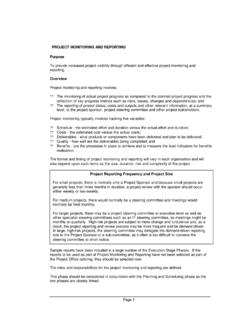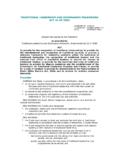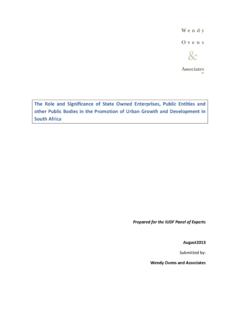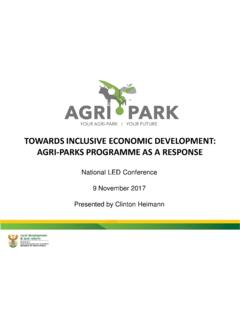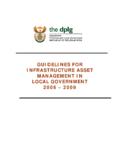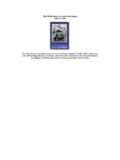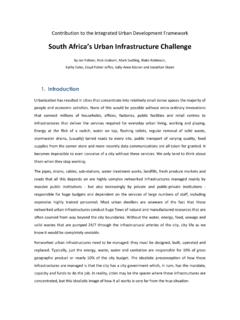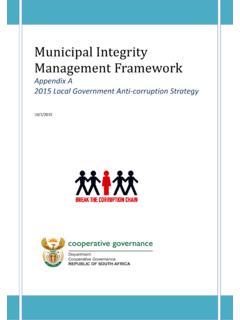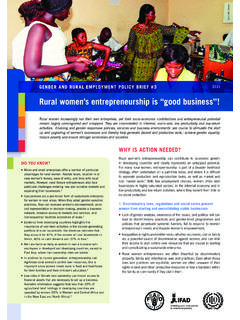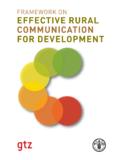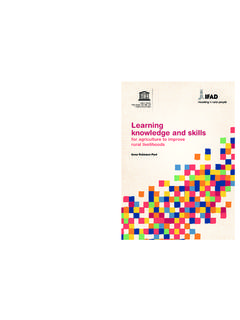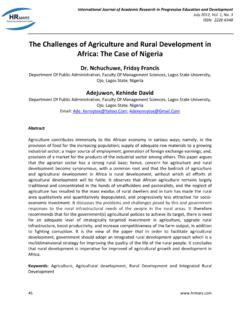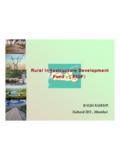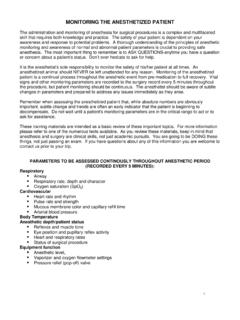Transcription of AN ANALYSIS OF RURAL-URBAN LINKAGES AND …
1 1 AN ANALYSIS OF RURAL-URBAN LINKAGES AND their implications FOR POLICIES THAT SUSTAIN DEVELOPMENT IN A SPACE CONTINUUM Lindile L. Ndabeni 1. INTRODUCTION RURAL-URBAN LINKAGES can be defined as the structural social, economic, cultural, and political relationships maintained between individuals and groups in the urban environment and those in rural areas1. RURAL-URBAN LINKAGES can also refer to spatial and sectoral flows that occur between rural and urban areas. Spatial flows include flows of people, goods, money, technology, knowledge, information, and waste. By contrast, sectoral flows include flows of agricultural products going to urban areas, and goods from urban manufacturing areas going to more rural areas2. Typically, RURAL-URBAN LINKAGES are often articulated in the nature and forms of migration, production, consumption, financial and some investment LINKAGES that occur within the RURAL-URBAN symbiosis.
2 The exchange of money, goods, visits including social activities, and communication with relatives and friends can all be used as indicators of RURAL-URBAN linkages3. Therefore, the nature and form of these LINKAGES are not homogenous as they are 1 Lesetedi, 2003 2 Tacoli, 1998 cited in von Braun, 2007 3 Action Against Hunger, 2012 2 CASH, GROCERIES, INPUTS, ASSETS FOOD urban rural PULL FACTORS Cheaper education, psycosocial support, retirement plan, cultural attachment PULL FACTORS Improved job opportunities, better health service PUSH FACTORS Drought, lack of income generating opportunities PUSH FACTORS High cost of living, job opportunities not realised, illness determined by both push and pull factors as highlighted in Figure 1-1. Figure 1-1: Push and Pull Factors in rural urban LINKAGES Source: Action Against Hunger, 2012 The influence of push and pull factors can differ from one place to another and for different sectors.
3 In most developing countries, especially low-income ones, urban areas symbolize a number of good things. They offer better jobs, respite from toiling on a farm without a decent income, safe drinking water, shorter distances to medical doctors and healthcare facilities4. These factors do not 4 Global Monitoring Report, 2013 3 only represent RURAL-URBAN dynamics but can also be an important source of rural poverty reduction5. The focus in this paper is to provide greater clarity and awareness about RURAL-URBAN LINKAGES as well as their impact on development and livelihoods across the two spaces. The emphasis is on how urban and rural areas intersect and how these LINKAGES can be mobilised for both urban and rural development.
4 Typically, the discussion as a whole examines the impact of RURAL-URBAN LINKAGES on livelihoods and transformations that occur in regional contexts rather than merely describing them. Accordingly, the paper highlights key drivers of RURAL-URBAN LINKAGES and recommend specific policies which can be used to achieve mutually beneficial relationships between rural and urban areas6. Likewise, the objective in this paper is to examine the notion of RURAL-URBAN LINKAGES and how they can be improved to reduce poverty and inequality, enhance inclusive development, and economic growth. Overall, the discussion emphasizes interdependencies that occur between the two spaces and is conceptualised in ways that enable the identification of specific entry points for policy development.
5 The vital importance of policy levers is that when they are used correctly, they can expand livelihood opportunities for both rural and urban inhabitants. Finally, this 55 Global Monitoring Report, 2013 6 Livelihoods in this paper are defined as the ability to earn an income that enables the individual or household to overcome vulnerability, maintain dignity, control their lives, take risks to seize opportunities, and rebound from setbacks in everyday life by meeting their needs and accruing assets, Yellow Wood Associates, 2011 cited in Dabson et al, 2012 4 paper attaches greater importance to the catalytic role that can be played by RURAL-URBAN LINKAGES in development. 2. THE POLICAL ECONOMY OF RURAL-URBAN LINKAGES SINCE 1913 The objective in this section is to demonstrate the need for rigorous policy ANALYSIS which takes a historical perspective within the political economy of policy making.
6 In particular, this section examines the evolution of urban - rural LINKAGES in South Africa since 1913 as well as their impact on both rural and urban development. The way in which these RURAL-URBAN LINKAGES have been articulated within the political economy of the apartheid spatial economy points to a fundamentally unbalanced relationship. Since 1913, RURAL-URBAN LINKAGES in South Africa occurred within a capitalist mode of production which evolved from a unique form of racial capitalism. Therefore, South Africa s RURAL-URBAN LINKAGES cannot be fully understood without reference to the overall structure and functioning of South Africa s political economy. That is to say, the historical ANALYSIS of RURAL-URBAN LINKAGES in South Africa cannot be addressed purely in economic terms as these LINKAGES have evolved in specific historical, socio-economic and political relations.
7 Accordingly, the ANALYSIS of RURAL-URBAN LINKAGES 5 in this section includes history, culture, political, social and economic issues that continue to shape RURAL-URBAN LINKAGES in South Africa. This ANALYSIS acknowledges the importance of giving attention to systemic forces and structural processes that produce and reproduce social realities. Furthermore, this ANALYSIS recognises the interplay of ideology, culture, economy, and development as these factors can enhance or constrain development. It was in June 1913 when the Land Act was passed. The Act disposed the majority of the population of their land and livelihoods7. In particular, the Act created a system of land tenure that deprived the majority (Blacks) of South Africans of the right to own land in White South Africa.
8 The Act divided South Africa into a racially divided world of White South Africa and Black Homelands or reserves. The reserves made up 8 percent of the land although this was later increased to 13 percent through the Native Trust and Land Act of 19368. In more explicit terms, the majority of South Africans (Blacks) were given 13 percent of land while the minority (Whites) owned 87 percent of the land. The significance of the Act is that it reduced the available land area which formed the backbone of the Black rural economy. 7 South Africa, undated 8 South Africa, 2012 6 The Act also abolished cash tenants and sharecroppers thereby reducing them into labour tenants or wage labourers. It led to the displacement of people and their relocation to the reserves.
9 This situation caused overcrowding in the reserves where few people could eke out a living on increasingly less land. In the reserves Africans could own land albeit without a secure tenure9. The traditional leaders (traditional chiefs) controlled the land in the sense that they could allocate the land to the members of the community10. The Land Act was the first major piece of segregation legislation that was passed by the White government and it became the major cornerstone of Apartheid South Africa. The passage of the 1913 Land Act marked the first comprehensive move towards legislative efforts that were aimed at ensuring territorial and racial segregation in South Africa. The 1913 Land Act as a cornerstone of territorial and racial segregation ignored the effects of centuries of cultural contacts between Blacks and Whites in South Africa11.
10 The maintenance of separate areas with distinct productive relations formed the basis of the racial policy of segregation. Segregation meant that the spheres of land and property 9 Skelcher, 2003 10 Letsoalo,1987 11 Legassick, 1974 7 ownership were racially separated. The Africans (Blacks) had to enter the White towns for the purposes of employment only. Arbitrary checks on passes were essential to maintain influx control. The Black spheres were insulated from the operation of the capitalist economy in so far as possible but yet the Black areas were insufficient to sustain a self-supporting peasantry and therefore extruded a migrant workforce12. As a result of the 1913 Land Act, the reserves became reservoirs of migrant labour13.
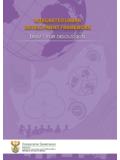
![Disaster Management Act [No. 57 of 2002]](/cache/preview/e/5/d/2/b/3/6/7/thumb-e5d2b36743b64ebe9204d7e874f734ad.jpg)
